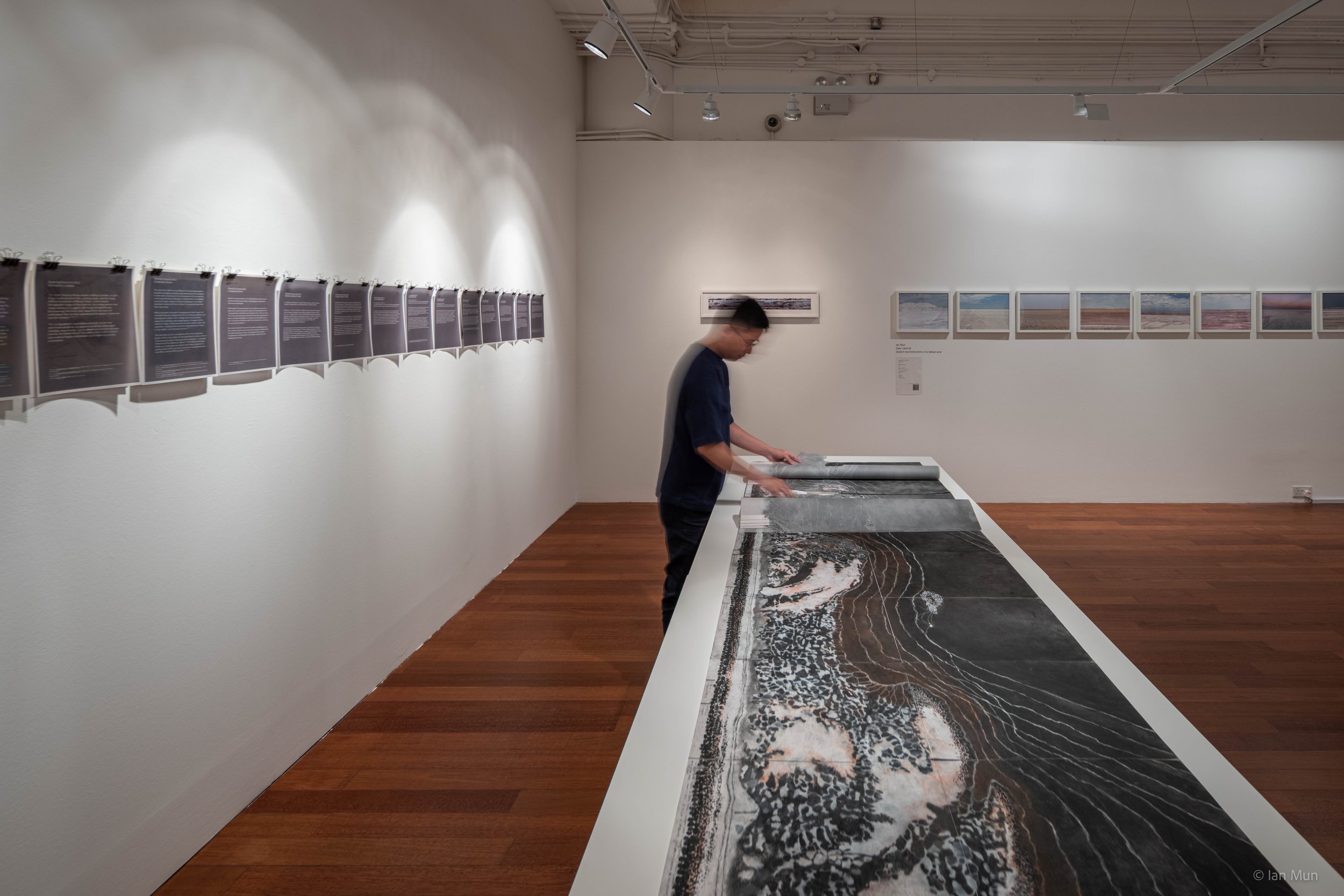
Embodied Cartographies: Drawing Encounters of an Ephemeral Landscape
By Wong Zi Hao, as part of a group show at NUS Museum’s
Prep-Room: Intimate Landscapes, 2021-2024
Collaborators: Goi Yong Chern, Lin Derong, and Ian Mun
Curators: Siddharta Perez, and Nurul Kaiyisah Binte Mohd Latip
Photography: Ian Mun
Embodied Cartographies presents the development of a method for encountering and knowing a landscape through its temporalities. The drawing research probes the intertidal zone—a temporal stratum of coastal geographies that dramatically changes with the rising and lowering of the tides—but is often omitted or represented partially in the official coastal maps, in which drawing conventions work to fix time in space. The research utilises the paper site of the drawing to explore time as qualities innate to the experience of an intertidal flatland, one of the last remaining along Singapore’s heavily reconstructed coastlines. It asks how should a map of time look like, and how might our imaginations of the coast—and consequently the way we work with it—transform by alternatively reading and representing the landscape through its temporalities? What does it mean to care for a landscape and its ecologies through the means and mediums of the site drawing?
This first iteration centres around two cartographic artefacts: a charcoal and chalk Map of intertidal flatlands at Sarang Rimau—unfolded and laid out on a reading table; and placed on top of it, a Book of Tides. The drawings when layered three-dimensionally into a physical model of the site, and when read alongside textual field/footnotes on the wall, are “drawing-model-texts” that construct an intimate view of the landscape. It is a different map of the coast—an embodied and experiential cartography where both maker and reader become acquainted with (and part of) the landscape through “a kind of intimate touching and close-up looking […and] going over something in order to become more familiar with it”.[1]
_________________
Intimate Landscapes is a curated discussion on methods: how to survey, document, map, draw, represent, write, collect, picture, archive, or narrate a landscape? Taking the format of the prep-room, the exhibition is a year-long studio-in-process, where three M.Arch graduates from NUS’ Department of Architecture (Lin, 2018; Mun, 2020; Goi, 2021) revisit their thesis archives, while a fourth who is presently undertaking a doctoral study at the DoA (Wong, PhD candidate 2018—2023) assembles a new drawing archive.
Whether through the individuals’ own creative research practices, and as a collaborative studio, weaving through all four of their archives is an enquiry to reconcile an idea of “landscape” that pits modes of subjectivity, experience, situatedness and affect (or being in a landscape), against usually irreconcilable and incompatible but dominant modes of knowledge-making (knowing about a landscape). Across different types of landscape sites—coastlines, intertidal beaches, highway infrastructures, sand hills, salt mines—the works present a detraction from traditional modes of reading and representing the vastness of landscapes, seen from the aerial and rather detached and disembodied viewpoints of maps and masterplans. These are the visual languages that tell of the expansiveness of terrain, extractive resources, and territory. Conversely the visual explorations grapple instead with a different scale of landscape: it is an “intimate view of details”, concerned with materialising and making visual what is intangible (meanings and ideas), or out-of-bounds (sand stores), or fleeting (temporalities, cultural appropriations), or unquantifiable (experience, ideologies, qualities).[2] Collectively through their methods of seeing, measuring, and documenting, they ask what might an intimate view of a landscape bring to the designers’ working bench or drafting board?
[1] Edward S. Casey, Earth-Mapping: Artists Reshaping Landscape (Minneapolis and London: University of Minnesota Press, 2005), xvi.
[2] Following Chee’s notion of ‘Intimate Encounter’, see: Lilian Chee, An Architecture of Intimate Encounter: Plotting the Raffles Hotel through flora and fauna (1887-1925, 1987-2005) (The Bartlett School of Architecture, University College London: Unpublished thesis, 2006). Also: Chee, Architecture and Affect: Precarious Spaces (UK: Routledge, 2023).




